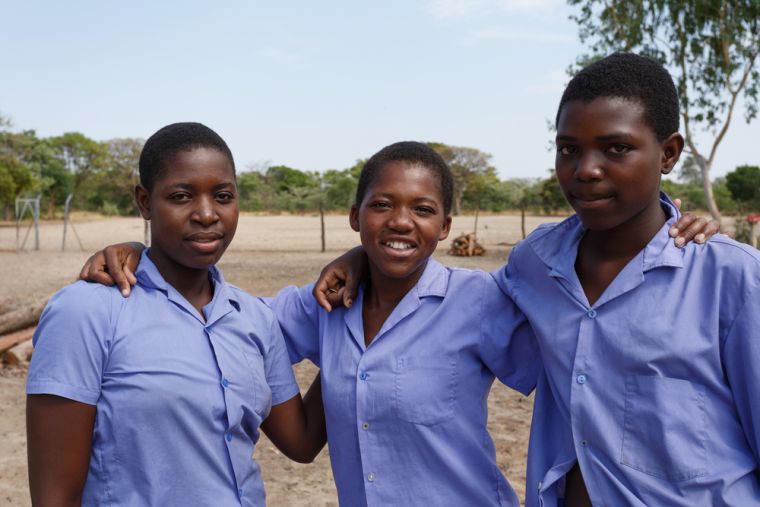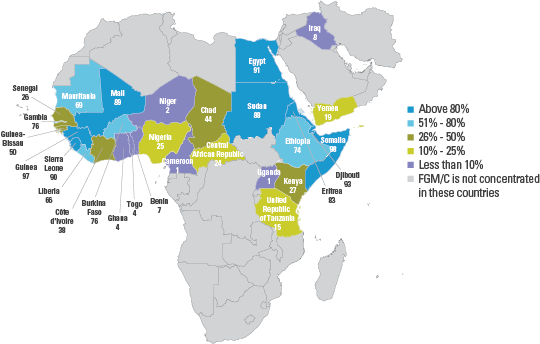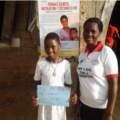What is Female circumcision/ Female genital Mutilation?
Female circumcision also known as Female Genital Mutilation (FGM), is defined as all procedures that involve partial or total removal of the external female genitalia. It also refers to all other procedures that result in injury to the female genital organs for non-medical reasons. The global prevalence of Female Genital Mutilation (FGM) ranges from 0.6% up to 98% and has many health and psychological impacts including abnormalities in female sexual function. Female circumcision is common in countries such as Egypt, Cameroon, Nigeria and Ethiopia.
Many countries in Western, Eastern, and North-Eastern Africa also engage in this practice. The practice is mostly carried out by traditional circumcisers, who often play other central roles in communities, such as attending childbirths. FGM is conducted from days after birth to puberty and beyond. More than 3 million girls are estimated to be at risk for FGM annually.
The Disadvantages of Female Circumcision
Female circumcision/ Female Genital Mutilation has no health benefits for girls and women but comes with several dangers, disadvantages and potential complications for both women and new borns. The dangers and side effects of female circumcision are:
- Procedures can cause severe bleeding and problems urinating, and later cysts, as well asVesico – Vaginal Fistula (VVF), a condition more commonly associated with the results of obstructed labor in early pregnancy but arising also in some cases from the cutting open of infibulated women;
- The removal or damage to highly sensitive genital tissues such as the clitoris, may affect sexual sensitivity and lead to sexual problems
- Female Genital Mutilation increases the risk of childbirth complications (difficult delivery, excessive bleeding, caesarean section, need to resuscitate the baby, etc.) and newborn deaths;
- Apart from the psychological consequences such as depression, anxiety, post-traumatic stress disorder, low self-esteem, etc, the long term health risks of female circumcision consist of chronic pain, keloid formation, and primary infertility.
- High risk of infections such as tetanus due to the use of old razor blades and traditional cutting devices and hepatitis/HIV due to the use of single cutting devices for multiple girl circumcisions without sterilization.
Female Circumcision in Africa
Although the practice of female circumcision can be found in many communities around the world, Africa appears to be the continent where the practice is most prevalent. Around 30 countries in Africa are known to practice female circumcision they include: Benin, Burkina Faso, Cameroon, Central African Republic, Chad, Cote d’Ivoire, Democratic Republic of Congo, Djibouti, Egypt, Eritrea, Ethiopia, Gambia, Ghana, Guinea, Guinea-Bissau, Kenya, Liberia, Mali, Mauritania, Niger, Nigeria, Senegal, Sierra Leone, Somalia, Sudan, Tanzania, Togo, Uganda and Zambia. In recent times Kenya has seen a setback in its progress to eradicate female genital mutilation (FGM) after an open parade in defiance of the government clampdown on the practice took place this week. Almost 2,800 girls from the Kuria community in south-western Kenya have undergone FGM.
Female circumcision in Nigeria
Nigeria, has the highest number of circumcised females in the world, accounting for about one-quarter of the estimated 115–130 million women who have either being circumcised women or whose genitals have been mutilated. Available data shows that 27% of Nigerian women between the ages of 15 and 49 are victims of FGM . In May 2015 it became illegal to circumcise a woman in Nigeria following the signing into law of a federal law banning Female Genital Mutilation in Nigeria. Click To Read Female Circumcision In Nigeria
Female circumcision In Asia
Some ethnic groups in Asia practice female circumcision including in communities in India, Indonesia, Malaysia, Pakistan and Sri Lanka.
Female Circumcision India : In India, female circumcision is practiced by the close-knit Dawoodi Bohra community, a Shia Muslim sect who consider the procedure known as khatna a religious obligation. In most cases, part of the clitoral hood is cut, but in some cases girls have had part, or all of the clitoris cut.
Female Circumcision in Malaysia: In 2009, Malaysia’s religious authority ruled circumcision was obligatory, unless harmful. A small study of Malay Muslims in north Malaysia found more than 90 percent of women had been cut, with 80 percent citing religious reasons. In 2012, the health ministry called for the procedure to be standardized.
Female Circumcision in Pakistan: As in India, female circumcision in Pakistan is carried out by the Dawoodi Bohra and remained a well-kept secret until very recently. It is typically performed on girls between the ages of six and nine years old. The Dawoodi Bohra community see FGM as a religious obligation.
Female Circumcision in Singapore: Female circumcision or Female Genital Mutilation is legal in Singapore and performed in clinics for around 20-35 Singapore dollars ($15-$26), adherents of this practice cite religious, cultural and hygiene reasons.
Female Genital Mutilation in Thailand: A ‘symbolic form’ of female genital cutting, a pricking or scratching of the clitoral hood is reported to be practised in Satun province, located on the Andaman of southern Thailand.
Female Circumcision/Genital Mutilation in Brunei: Female circumcision or female genital mutilation is legal in Brunei. Brunei Darussalam supported calls to end female genital mutilation. The practice of female circumcision carried out in Brunei was not considered as female genital mutilation, as confirmed by the World Health Assembly in 2008. .
Female Genital Mutilation in Madives: Female circumcision or female genital mutilation is legal in Maldives. It has been actively encouraged by some influential Islamic scholars. One issued a fatwa in 2012 saying female circumcision was “part of nature”.
What religion requires female circumcision?
Female Genital Mutilation is erroneously linked to religion. Historical records of female circumcision shows that it predates Christianity and Islam. FGM is practiced among some adherents of the Jewish, Muslim and Christian faiths. Female circumcision is also practiced among some animists, who believe in the existence of individual spirits and supernatural forces.
Female circumcision in Islam?
According to the minaret, islamic law protects a woman’s right to sexual enjoyment, as demonstrated by the fact that a woman has the right to divorce on the grounds that her husband does not provide sexual satisfaction. It follows that Islamic law prohibits clitorodectomy (partial or complete removal of the clitoris) or infibulation (excision of part or all of the external genitalia and stitching/narrowing of the vaginal opening), or any genital mutilation which impairs the woman’s ability to enjoy sexual relations. Such prohibitions are consistent with the hadithic warning against severity in female circumcision. Opponents of this school of thought such as Dr. Haamid al-Ghawaabi of islamqa who averred that Female circumcision has not been prescribed for no reason, rather there is wisdom behind it, and it brings many benefits. He stated that secretions of the labia minora accumulate in uncircumcised women and turn rancid, so they develop an unpleasant odour which may lead to infections of the vagina or urethra. He further stated that circumcision reduces excessive sensitivity, which is very annoying to the husband, especially at the time of intercourse stressing that female circumcision also reduces the excessive desire for sex.
What countries is female circumcision illegal?
Criminal Legislation/Decree (year enacted)
African Nations:
Benin (2003)
Burkina Faso (1996)
Central African Republic (1966)
Chad (2003)
Côte d’Ivoire (1998)
Djibouti (1994)
Egypt (2008)
Eritrea (2007)
Ethiopia (2004)
Ghana (1994)
Guinea (1965, 2000)
Kenya (2001)
Mauritania (2005)
Niger (2003)
Senegal (1999)
South Africa (2005)
Tanzania (1998)
Togo (1998)
Nigeria (2015)
Industrialized Nations:
Australia (6 of 8 states, 1994-97)
Belgium (2000)
Canada (1997)
Cyprus (2003)
Denmark (2003)
Italy (2005)
New Zealand (1995)
Norway (1995)
Spain (2003)
Sweden (1982, 1998)
United Kingdom (1985)
United States (Federal law, 1996; 17 of 50 states, 1994-2006)
Read Causes and Remedies of Pimple Like Bump on Clitoral Hood







1 Comment